
This story began for me in 2017 when I discovered that my fourth-great grandfather, Isaac Behunin, named Zion National Park. This canyon became a place of rest after a long and weary life in which he traveled thousands of miles on foot. This became his cathedral. This story originally began as a nod to Zion National Park history, but then it evolved and it took on new meanings for me. Now, it is a very personal testament to the power that places have to draw us near in ways that we cannot quite explain. It is also about how the natural world speaks to my soul and connects me to the divine. And finally, this story is about how sometimes, places where our ancestors have a way of beckoning us in the most uncanny ways. In short, this is a story of awe.
Before Landing in Zion:
The hero of our story is Isaac Behunin who converted to the Mormon church in the very early days and the whole family made the trek west in the Milo Andrus company.
After arriving in the Salt Lake Valley, he and his family were the very first Mormon Pioneers to stop their wagons in what is now the town of Ephraim. As a first item of business, Isaac Behunin directed his sons to build a dugout, which caused other settlers to scoff. Who would want to live in the mud underground? Within days, however, a massive early blizzard hit. It was so cold that the animals outside froze to death. The Behunin family spent their winter in comparative warmth and comfort (even with all the snakes) when others were camping in wagons. (Reference: this story is told in Saga of the Sanpitch, by Macel B. Anderson, on file in the Snow College Archives.)
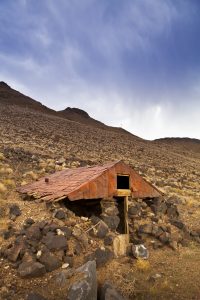
Isaac and his family then built the first sawmill in Ephraim on Pine Creek. Sometime after the original dugout he and his family built a beautiful home of oolitic limestone in the nearby town of Spring City. It is located at 19 East, 100 South in Spring City, Utah in Sanpete County.

Later, Isaac Behunin built the first cabin in Springdale, in the shadow of Zion National Park. This is the place that became his personal sanctuary and temple. By this time, he was a weary religious refugee, having journeyed 3,500 miles on foot and by covered wagon. He had lived in 22 temporary homes including that dugout their first winter in Ephraim. It is hard to wrap my mind around all the hardship that he experienced in one lifetime.
He named his cathedral and sanctuary Zion
The State of Utah’s Division of History site says this:
Isaac is credited with giving Zion Canyon its name, when in the presence of friends and the grandeur of the canyon, he said, “A man can worship God among these great cathedrals as well as he can in any man-made church; this is Zion.”
The family account goes on to say that Isaac would sit in silence for long stretches, soaking in the grandeur of that sacred place. He had truly found a place of peace and refuge. In his old age, he could no longer care for his own place there in Springdale and moved to “Long Valley.” He is buried in the Mt. Carmel cemetery, where a marker honors him. Elijah C. Behunin said this about Isaac Behunin’s last days:
“My father never left Zion because of trouble with anyone. He was a quiet, unassuming man who minded his own business and wanted everyone else to do the same. He was a very temperate man and beloved in Mormonism. He died in the belief of a glorious resurrection.”
Isaac Behunin is buried at the Mt. Carmel cemetery.
Reading about his restful solitude in Zion canyon, I feel a kindred spirit to this man because the towering cliffs and sandstone have spoken to my own soul from the moment I set foot there. I was a young adult when I first spent quality time in Zion National Park and from that first visit I had an oddly incongruent feeling that I was home. When I first visited, it instantly felt like the red sands, desert plants, and arid breezes were in my DNA. I now know that I have connections I did not understand when I experienced these other-worldly feelings. Could genetic connections be why? Or is it simply that beautiful places speak to anyone who stops long enough to listen?
I can’t know, of course, but this whole story does make me wonder if our ancestors beckon us to places where they lived, or if somehow our DNA contains wisps of memory we have yet to understand. Today, these wild spaces of the western desert are sacred to me. This is where it feels like feet are on the ground.
Related article: Power of Place
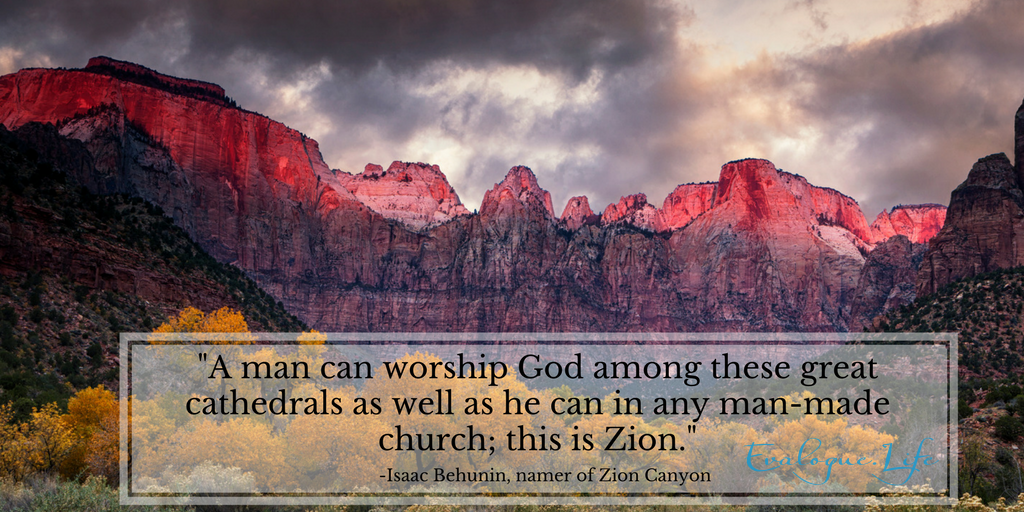
Brigham Young resisted the name Zion
The story goes that Brigham Young, who never visited the actual Zion canyon, wasn’t enamored of the name or the place. One account said that when Brigham Young visited Springdale, he found tobacco growing and old distilling whiskey. Related to the name, an account on FamilySearch tells the story:
It was great-grandfather Isaac who proposed the name….He wrote a letter to President Brigham Young and he said to him, “Come on down and bring the saints down here. You stopped too soon because I have actually found Zion.”
President Brigham Young wrote a letter back and he said, “That is not Zion,” he said, “Zion is where the saints are at.” Reference link here.
I love the lore that local folks responded by calling it “Not Zion,” or “Little Zion” which surely contributed to the fact that the name stuck. The above account continues:
“Old father Behunin proposed the name Zion, to which the others agreed. Isaac Behunin had been with the Mormons ever since they left New York…Here in Zion he felt that at last he had reached a place of safety where he could rest assured of no more periling and persecutions. No wonder he proposed the name Zion, which inspires a resting place.”
This canyon was Zion to the people who lived here:
Regarding the name, Isaac’s son, Elijah C. Behunin (my third-great uncle) wrote this in his personal history:
“We never called this section ‘little Zion’ either, it has always been Zion to us. When Brigham Young came to Springdale he advised the people to call this section “No Zion” (Sic?) but I only know of two people who ever applied that name to this canyon. Brigham Young always thought of “Zion” as Jackson Co. Missouri, but this canyon was Zion to people who lived here. Brigham Young never came up into the canyon. In fact, he was at Springdale about 1867, but there was nothing but a trail reaching up into Zion at that time.”
Behunin Posterity:
A 1979 family history says that, “The lineage of Isaac Behunin is scattered far and wide throughout the nation. Wherever they are, they are known to be talented and progressive people.” (As reference: here is a link to information in FamilySearch: Reference link here.)

The Isaac Behunin story keeps evolving for me:
 Now fast forward a year from the time I originally wrote this article. In the summer of 2018, an architect friend of mine, Shalae Larsen, asked if I would be interested in researching the Ephraim Relief Society Granary and then write the narrative portion of a National Historic Register nomination. That building is now home to Granary Arts. I was excited about the job and I remembered my many ancestors who lived in Sanpete County.
Now fast forward a year from the time I originally wrote this article. In the summer of 2018, an architect friend of mine, Shalae Larsen, asked if I would be interested in researching the Ephraim Relief Society Granary and then write the narrative portion of a National Historic Register nomination. That building is now home to Granary Arts. I was excited about the job and I remembered my many ancestors who lived in Sanpete County.
When I I made my first visit to see the Relief Society Granary in person I parked right next to a monument that honored the original settlers of Ephraim Fort. In other words, there is a monument to my ancestor and others located on the very property that I had been hired to research! I had no idea. A block down the street is another monument that names Isaac Behunin. (As side personal note, that monument also mentions another of my ancestors by name, Reddick Newton Allred.)
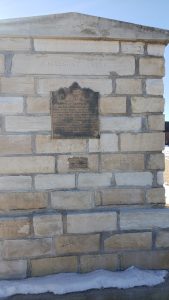

Then, in January of 2019 I was at the Church History Library in Salt Lake City doing additional research for the the Ephraim Relief Society Granary and while immersed in microfilm looking for something else, I happened to scroll onto these wonderful drawings of Isaac’s rock home in Spring City (below). They were done by students as part of a project to catalog vernacular architecture in Sanpete County. That project was led by Professor Thomas Carter, with whom I had breakfast a few weeks prior. This project had been started early in Carter’s career, but it took him until the end of his career to be ready to publish a wonderfully beautiful book, Building Zion, The Material World of Mormon Settlement. In that book. my spirit thrilled to find not only the story of Isaac Behunin, but other ancestor stories and voices–especially of women I knew nothing about before. I wept more than once finding details that I’ve never seen elsewhere. Again, I felt that deep kinship.
Read related article: Finding forgotten voices in the Church History Library
Hence, this national historic register nomination project was not just a paid job as I had originally thought. This was the story of my people. I should also point out that while this particular blog story is about a paternal ancestor, the research I was doing for the Relief Society Granary especially honored the women whose stories are largely lost to history. But in the Church archives, the voices of women came to life through their minutes.

Then, about six months later at the end of January 2019, I had the chance to work as a “creative-in-residence” at GranaryArts in the C.C.A. Christensen cabin. For several days, I got to work on land that my ancestors settled.
And as if to push the envelope of just how weird this whole saga might get, there is another uncanny tie. The architect who partnered with with me on the Ephraim Granary national register nomination, Shalae Larsen (IO Landscape Architecture) is a direct descendant of C.C.A. Christensen. When she was invited to do this job, she had no idea that her ancestor’s cabin was on the very property where we would be working!
Oh, and when I was sitting at the Church History Library with the drawing of Isaac Behunin’s house open in front of me. The man next to me asked what I was working on and he said, “I know the Granary well. I am researching C.C.A. Christensen for an article in Pioneer Magazine.” What?! Of all the days and times, two people were sitting side-by-side looking at microfilm files related to Behunin and Christensen. That’s freaky.
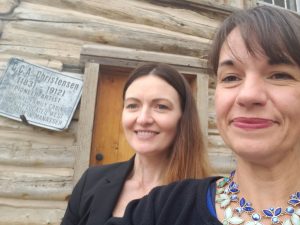
So, both Shalae Larsen and I had ancestors with ties to the very place we were researching. Of all the people in the state who could have worked on this job, why the two us? Why did it come to two out-of-towners with no network or current connections in Ephraim today?
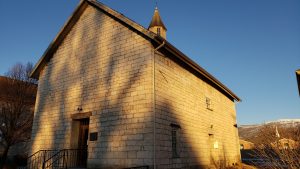
In short, each time I found a detail, story, or voice, I have felt a quiet sense of wonder that I still cannot quite explain. As “out there” as may sound, I have come to believe our ancestors want to be remembered. If we show an interest, they have ways of beckoning us closer and revealing their lives to us.
Related article: The power of remembering ancestors
These stories have a way of drawing you in and not letting you go until they are good and done with you. Someday, I hope I get to meet Isaac Behunin on the other side and say, “Hey, I know you!”

Rhonda Lauritzen is the founder and an author at Evalogue.Life – Tell Your Story. Rhonda lives to hear and write about people’s lives, especially the uncanny moments. She and her husband Milan restored an 1890 Victorian in Ogden, Utah and work together in it, weaving family and business together. She especially enjoys unplugging in nature. Check out her latest books: How to Storyboard, and Remember When, the inspiring Norma and Jim Kier story.
Subscribe!

Get our weekly email with tips to tell your story and the Sunday Edition. (Free, of course)


Isaac Behunin is my direct 5th generation great grandfather. Isaac – Mosiah Stephen – George Albert – George Harold – George Frank to me Terry B. Behunin. Appreciated your story, it reconciled well with all my research too. Thank you.
Terry – Thank you so much for your comment. It is thrilling to be connected to more extended family!
I very much enjoyed this story & history. It is amazing how things happen in our lives. Goosebump moments!!
Nancy you are so right about the goosebumps moments. Doing this work I have experienced so many uncanny coincidences I could go on and on. Thanks for your comment.
Isaac Behunin is my third great grandfather. Great article, I will share it on our Behunin/Guymon FB page. Isaac, Isaac Morton, William Isaac, Crystal Behunin Guymon is my line. Nice to meet you cousin.
Kathryn, Wow! Nice to meet you too. Thanks for your comment here and thanks also for sharing. It makes my heart happy to see that family members are seeing this. We have a lot to be proud of.
I have just discovered that Isaac Behunin os my third great Grandfather,this is very interesting.
Through which line? Let’s see how we are related. I am glad you liked this story – Isaac Behunin has really captured my heart.
My mom is a Behunin (Buchanan) and I love to visit knowing my ancestors were strong in both spirit and body to have settled there.
Heather, wow! It makes me happy to see that you found this and learned more about your family. Did the name Behunin later change to Buchanan? If so, I had no idea!
Good job Rhonda, I enjoyed reading your article on my great great grandfather. Janet and I enjoy Zion canyon and reading about the history.
Rod, thank you for your lovely comment on my article. And I apologize for not acknowledging your comment sooner: it got flagged as spam originally and I just saw it now. Isn’t it fun to have this heritage?